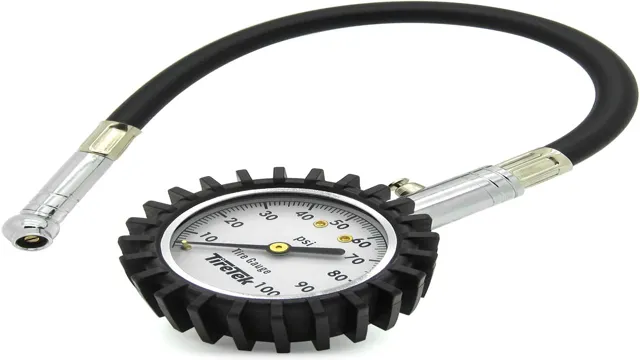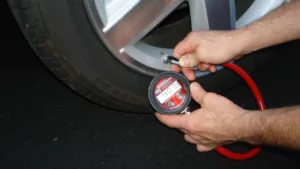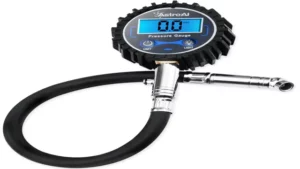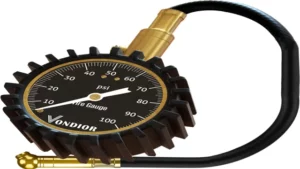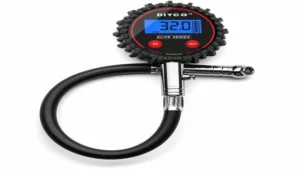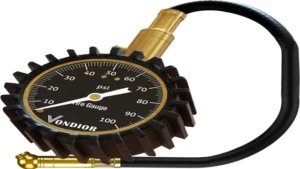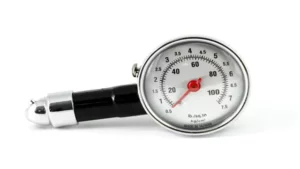Tire pressure gauges are an essential tool for any car owner or mechanic. Keeping your tires inflated to the correct pressure helps to ensure your vehicle’s safety on the road, as well as improving its fuel efficiency. However, just like any other tool, tire pressure gauges require calibration to ensure their accuracy.
If you’re wondering how to calibrate a tire pressure gauge, you’re in the right place. In this blog, we’ll walk you through the process of calibrating your gauge so that you can trust it to give you reliable readings every time you use it. So, let’s get started!
Why You Should Calibrate Your Tire Pressure Gauge
If you want to ensure the accuracy of your tire pressure gauge, it’s important to know how to calibrate it properly. Over time, tire pressure gauges can become inaccurate due to regular use and exposure to different environments. This can lead to incorrect readings, causing tire underinflation or overinflation, which can compromise your vehicle’s performance, safety, and fuel efficiency.
By learning how to calibrate your tire pressure gauge regularly, you can avoid these problems and keep your tires in top condition. Calibration involves comparing your gauge’s reading with a known accurate pressure source, adjusting the gauge accordingly, and ensuring future readings are accurate. It’s a simple process that can save you costly repairs and potential accidents on the road.
So, don’t neglect the importance of calibrating your tire pressure gauge – it’s an easy step that can keep you and your vehicle safe and efficient.
Improper Calibration Can Lead to Inaccurate Readings
Proper calibration of your tire pressure gauge is essential to its accuracy. Failing to calibrate your gauge can lead to inaccurate readings which can be dangerous when driving. Imagine thinking your tires are properly inflated, only to find out they are actually low on air, and you’re driving on a highway with high speeds.
That can be a recipe for disaster. Calibration ensures that your gauge is measuring pressure correctly, giving you confidence and peace of mind while driving. So don’t take chances with your tire pressure gauge, make sure it’s properly calibrated before use.
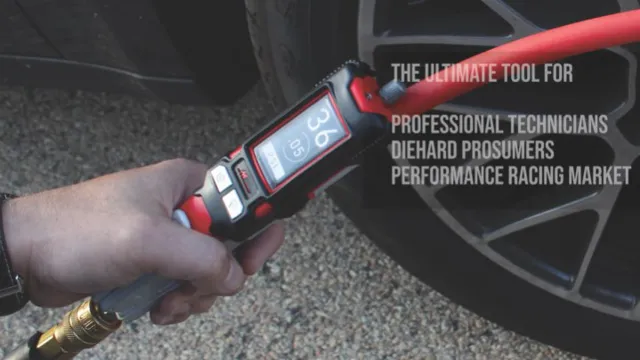
Regular Calibration Will Ensure Your Gauge is Accurate
If you rely on your tire pressure gauge to ensure the safety and efficiency of your vehicle, it’s important to regularly calibrate it. Over time, gauges can become less accurate due to wear and tear, which can lead to under or overinflated tires. This can affect your gas mileage, handling, and even the lifespan of your tires.
Calibration helps ensure that your gauge is properly measuring the pressure, so you can trust the readings it provides. It’s a simple process that involves comparing the gauge’s reading to a known accurate pressure source and adjusting the gauge if necessary. By taking the time to calibrate your gauge, you can have peace of mind knowing that your tires are properly inflated and your vehicle is performing at its best.
So don’t overlook this important maintenance step – keep your gauge calibrated for safe and efficient driving.
What You Will Need to Calibrate Your Tire Pressure Gauge
If you want to make sure your tire pressure gauge is giving you accurate readings, you’ll need to calibrate it from time to time. But what exactly do you need to do that? Firstly, you’ll need a tire pressure gauge calibration tool or an accurate reference gauge. This tool should measure pressure with extreme accuracy, so you can verify your gauge’s readings.
Next up, you’ll need a reliable air source to add or remove pressure from the gauge as needed during calibration. This could be an air compressor or a bicycle pump, depending on the type of gauge you have. Finally, you’ll need to make sure you have a well-lit, flat workspace to perform the calibration.
Try a simple test to gauge the accuracy of your tire pressure gauge before you calibrate it. This way, you’ll have a better idea of how far off the readings might be, and you’ll know what kind of adjustments to make. By following these steps and using the right tools, you’ll be able to calibrate your tire pressure gauge with ease and confidence.
A Reliable Tire Pressure Gauge
If you’re looking for a reliable tire pressure gauge, you need to have the right tools in order to calibrate it properly. Firstly, you’ll need a tire pressure gauge that is accurate and easy to read. It’s important to note that not all tire pressure gauges are created equal.
Investing in a high-quality gauge will ensure that you get an accurate reading every time you check your tire pressure. Secondly, you’ll need a tire pressure calibration tool to calibrate your gauge. This tool is used to reset your gauge to zero before taking a measurement.
By regularly calibrating your tire pressure gauge, you’ll be able to keep it accurate and reliable for years to come. Overall, having the right tools will not only make checking your tire pressure easier, but it will also ensure that your gauge is giving you accurate readings for your safety on the road.
A Compressed Air Source
When calibrating a tire pressure gauge, having a compressed air source is crucial. This can be achieved through an air compressor, a tire inflator, or even a manual pump if necessary. Additionally, it’s important to have the right attachment pieces for your specific gauge and air source.
Some gauges may require a screw-on adapter while others may use a push-fit style attachment. Make sure to double-check what is needed for your specific gauge to ensure accuracy in the calibration process. Without a reliable and accurate source of compressed air, calibrating your tire pressure gauge may not produce accurate readings and result in potential safety hazards on the road.
A Calibration Tool or Master Gauge
Are you tired of inaccurate tire pressure readings? It’s time to calibrate your tire pressure gauge! To do this, you’ll need a calibration tool or master gauge. A calibration tool is used to measure the accuracy of your tire pressure gauge. It is important to have one because inaccurate readings can lead to under-inflated or over-inflated tires, resulting in poor gas mileage, reduced tire life, and even accidents.
To calibrate your tire pressure gauge, you’ll need to first check the pressure of your tire with a master gauge, which is a calibrated tool used primarily for testing the accuracy of tire pressure gauges. Then, compare the readings of your tire pressure gauge to the master gauge and adjust your gauge accordingly. Regular calibration ensures that your tire pressure gauge always gives accurate readings, leading to safe and cost-effective driving.
Steps to Calibrate Your Tire Pressure Gauge
If you’re wondering how to calibrate a tire pressure gauge, the good news is that it’s a fairly simple process. The first step is to check the accuracy of your gauge using a known pressure source, such as a calibrated gauge or an air compressor with a pressure gauge. Next, adjust your gauge if necessary using a small screw located on the back or side of the gauge.
Once your gauge is properly calibrated, you can start using it to measure your tire pressure. It’s important to note that tire pressure should be checked at least once a month and before long road trips to ensure safety and optimal performance. By taking the time to calibrate your tire pressure gauge, you’ll have the peace of mind knowing that you’re getting accurate readings every time.
Step 1: Check Your Tire Pressure Gauge
If you’re interested in calibrating your tire pressure gauge, the first step is to check your gauge itself. Often, gauges can become inaccurate over time due to normal wear and tear, so it’s essential to ensure that your tool is still delivering accurate readings before you begin. To check, compare your gauge to a known reliable pressure source.
For example, if you have a digital gauge, you could compare it against a mechanic’s air-powered tool. A few PSI difference could be acceptable, but if the readings vary too much, it’s best to buy a new gauge. This step is crucial because if your gauge is already out of calibration before you begin the process, you will not achieve accurate results.
By verifying your gauge’s accuracy beforehand, you can be confident in the calibration process’s accuracy and ensure that your readings are as precise as possible.
Step 2: Record the Reading of Your Gauge
Once you have gathered all the necessary tools and checked your gauge’s accuracy, it’s time to start calibrating. The second step is to record the reading of your gauge. This will serve as your reference point for the rest of the process.
To do this, remove the cap of the valve stem and attach the gauge. Ensure that there are no leaks or hissing noises. Next, hold the gauge in place firmly and read the pressure.
It’s important to hold the gauge straight to avoid any inaccurate readings caused by an angled position. Write down the pressure reading and keep it handy. You can even take a photo of the reading for convenience.
Once you have the initial reading, move on to adjusting the gauge’s zero setting or the calibration screw, if necessary. By keeping careful notes and taking your time with each step, you’ll be able to calibrate your tire pressure gauge quickly and efficiently.
Step 3: Connect Your Gauge to the Master Gauge/Calibration Tool
When it comes to calibrating your tire pressure gauge, it’s important to follow the proper steps to ensure accuracy and safety on the road. Step 3 is connecting your gauge to the master gauge/calibration tool. This step involves attaching your gauge to a tool that has been accurately calibrated and meets industry standards.
This tool serves as a reference point to compare your gauge’s readings and make any necessary adjustments. By connecting to a master gauge/calibration tool, you can ensure that your gauge is functioning properly and giving accurate readings. Remember, accurate tire pressure readings are essential for maintaining proper inflation levels and ultimately keeping you safe while driving.
So, take the time to properly calibrate your gauge and stay proactive about maintaining your tire health.
Step 4: Compare the Reading of Your Gauge to the Master Gauge/Calibration Tool
After completing the third step of adjusting your gauge, you should now compare its reading to the master gauge or calibration tool to ensure its accuracy. Start by attaching your gauge to the tire valve stem and reading the pressure displayed. Then, attach the master gauge to the same tire valve stem and compare the reading.
If there is a significant difference, it may be time to replace your gauge. However, if the difference is within a reasonable range, you can adjust your gauge accordingly. Some gauges have a small screw or nut that can be turned to adjust the reading, while others require a more complex calibration process.
It is essential to ensure that your gauge is calibrated accurately, as improperly inflated tires can lead to poor handling, decreased fuel efficiency, and even tire failure. By following these simple steps, you can rest assured that your tire pressure gauge is accurate and your tires are properly inflated, ensuring a safe and smooth ride.
Step 5: Adjust Your Gauge Accordingly
When it comes to using a tire pressure gauge, accuracy is everything. That’s why it’s important to calibrate your gauge regularly to ensure it’s providing you with an accurate reading. Once you’ve determined your gauge needs calibration, the next step is to adjust it accordingly.
If your gauge is reading too high, you’ll want to lower it by gently pressing on the valve stem with a flathead screwdriver until you reach the desired reading. If it’s reading too low, you’ll want to increase it by turning the adjustment screw in the opposite direction. It may take some trial and error to get your gauge adjusted just right, but once you do, you’ll be able to trust that your tire pressure readings are accurate and reliable.
Remember to always test your gauge against a known accurate gauge to ensure you’re getting the most accurate reading possible.
Conclusion
In summary, calibrating a tire pressure gauge is like a science experiment for your car. It requires precision, accuracy, and attention to detail. But don’t let that scare you off.
With the proper tools and a little bit of patience, you can ensure your vehicle is running smoothly and efficiently. So go ahead and give your tire pressure gauge the tune-up it deserves – your car will thank you for it!”
Regular Calibration Ensures Accurate Readings and Prolongs the Life of Your Gauge.
Regular calibration of your tire pressure gauge is essential to ensure the accuracy of your readings and prolong the life of your gauge. Over time, temperature changes, moisture, and other factors can cause your gauge to lose accuracy, making it important to calibrate it regularly. Luckily, calibrating your gauge is a simple process that you can easily perform at home.
Firstly, locate a calibration source; this source may be a calibration machine or another calibrated tire pressure gauge. Next, adjust the gauge to match the calibration source’s readings. Make sure to repeat the process multiple times to ensure accuracy, and always follow the manufacturer’s instructions for your specific gauge.
By calibrating your gauge regularly, you can trust that your tire pressures are accurate and prolong the life of your gauge. Don’t forget to calibrate your gauge before and after using it to ensure accuracy, so you can keep your wheels in optimal condition.
FAQs
What is the importance of calibrating a tire pressure gauge?
Calibrating a tire pressure gauge helps to ensure that it provides accurate readings, which in turn helps to maintain the safety and performance of a vehicle.
How often should a tire pressure gauge be calibrated?
Some manufacturers recommend calibrating a tire pressure gauge before each use, while others suggest doing so once a month or every six months. It’s important to follow the manufacturer’s guidelines.
What are some common methods for calibrating a tire pressure gauge?
Common methods include comparing the gauge to a known accurate gauge or using a calibration tool specific to the gauge.
Can a tire pressure gauge be calibrated at home?
Yes, many tire pressure gauges come with instructions for at-home calibration using a calibration tool or another accurate gauge.
What are some signs that a tire pressure gauge needs to be calibrated?
Inaccurate readings, difficulty reading the gauge, and physical damage to the gauge may be signs that it needs to be calibrated.
Can a tire pressure gauge be calibrated if it is damaged?
If the gauge is damaged, it may need to be replaced rather than calibrated. Check with the manufacturer or a professional for guidance.
Is it necessary to calibrate a digital tire pressure gauge?
Yes, digital tire pressure gauges still require calibration to ensure they are providing accurate readings. Calibration methods may differ from those for analog gauges.
